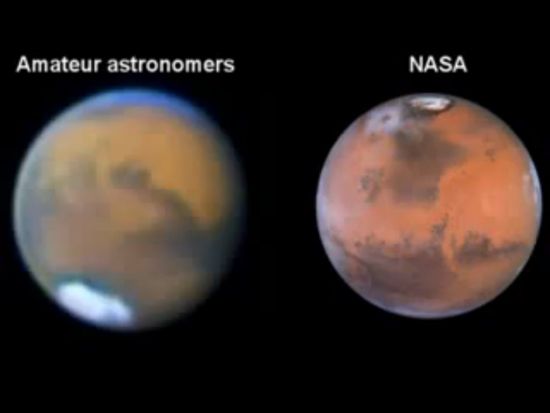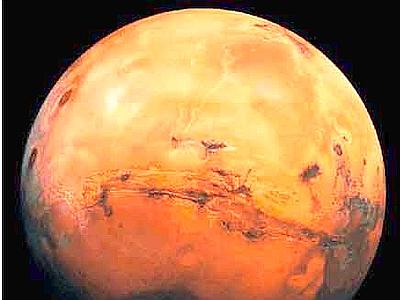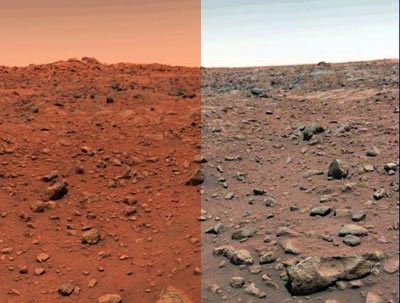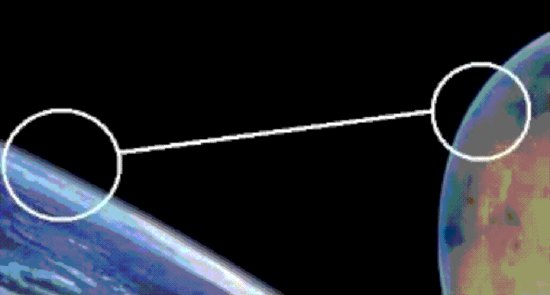 The planet Mars is also called the red planet because of the abundance of iron oxide present in its surface rocks. And 'the color that make us see the images of NASA. Too red, the sky is instead described as being yellowish-brown. Among the amateurs are finding a doubt about the authenticity of the images official color.
The planet Mars is also called the red planet because of the abundance of iron oxide present in its surface rocks. And 'the color that make us see the images of NASA. Too red, the sky is instead described as being yellowish-brown. Among the amateurs are finding a doubt about the authenticity of the images official color.First, because the planet taken from amateur telescopes does not seem as reddish as in the photographs of NASA? Indeed, it appears with streaks of green and blue?
Color theory artifacts, which would be painted the planet, would be consistent with the pictures that show dark patches of vegetation ( forests Martian ) and ice caps of some bluish-colored ( Climatology of the Red Planet ).
Here are some examples of comparative photos:


Very dark areas are also apparent in photographs of melting curve analysis, inispecie in the equatorial zone, without any convincing explanation provided.
If exist on Mars plant being capable of photosynthesis, namely oxygen in the air, the sky should not appear yellowish like the pictures that the various little robots sent to the surface we send.
Moreover, the presence of such oxide in the surface rocks might suggest that a fair amount of molecular oxygen (blue) is present in the air of Mars. In addition to the recombination of CO 2 and other oxygen compounds that constitute over 95% the atmosphere.

Even images taken by the space telescope Huble contain the color blue (above) in the atmosphere of Mars otherwise absent in the most famous photo (below).

It can be assumed that if the intent of astronomy canonical hide the presence of life on Mars, the US space agency may have altered through filters the true colors of the planet. Astronomers should explain the origin of the blue color of the sky Martian .

'Cause the ground to the left is so heavily reddish?
Numerous studies on photographs sent from the centers of acquisition appear to have been "altered" as to hide the tones green-blue that would put in crisis scientists intent on convincing the public that Mars is a dead planet, just a cold and red rocky desert. NASA often calls in "false color" certain photographs reddish Mars while books and newspapers falsehood color is omitted.

Comparison of color of Earth's atmosphere and the Martian taken from Hubble
Just as it is not specified the reason why the cameras on board of numerous probes operate only in altered colors by filters or even black and white (!) As in the case of the probe Rosetta .

There are photographs taken from the "lander" the first Viking '76 that clearly show tones of blue, just analyze the image with any graphics software, if one does not trust its own monitor.
Every so often emerge photographs that appear realistic thus causing also an issue little discussed: the fact that the light on the Martian surface to be similar if not greater than that which illuminates the surface of the Earth. In fact, the red planet is about 80 million km further away from the Sun in our (but there are only 50 million km from its perihelion and our aphelion ) then, as the atmosphere much less thick, a higher percentage of light should reach the ground. The photograph below shows probably the real Martian landscape.

The true colors of Mars (Viking 1). Luminasa day, blue-white sky and the ground of a similar color to the equivalent recco homegrown.
If you have a way to directly observe Mars through a telescope you do the test withhours!
http://pianetax.wordpress.com/veri-colori-di-marte/









Why they do this?
ReplyDeleteI know this is old....but the real answer is rayleigh scattering, which is also the reason the sun appears yellow from Earth, but is in fact white when viewed from space. NASA colorizes images of the sun taken from space to make them appear more yellow, and they do the same for Mars.
ReplyDeleteThe picture of Viking 1 has also been altered, which is why the sky is so blueish -- it was white-balanced to make seeing the rocks easier, which is common and well documented.
Three seconds in google could easily answer these "questions"....
https://en.wikipedia.org/wiki/Rayleigh_scattering
https://www.quora.com/Does-Mars-have-a-blue-sky